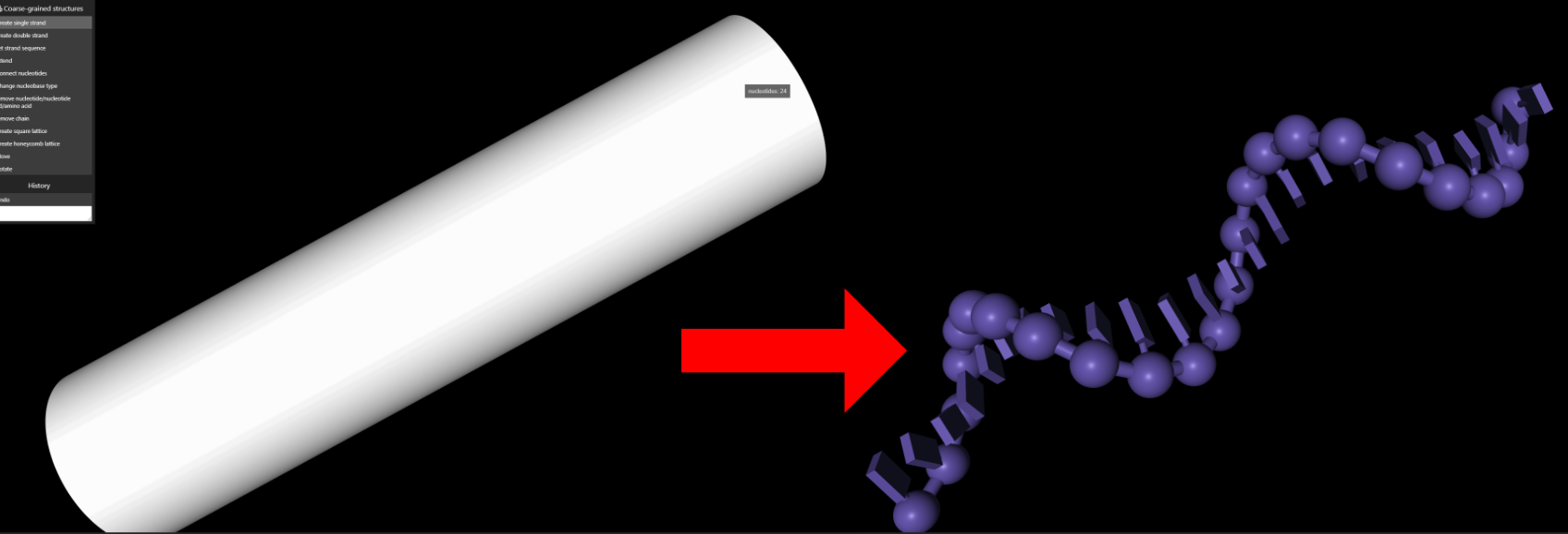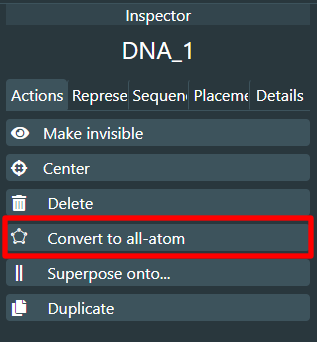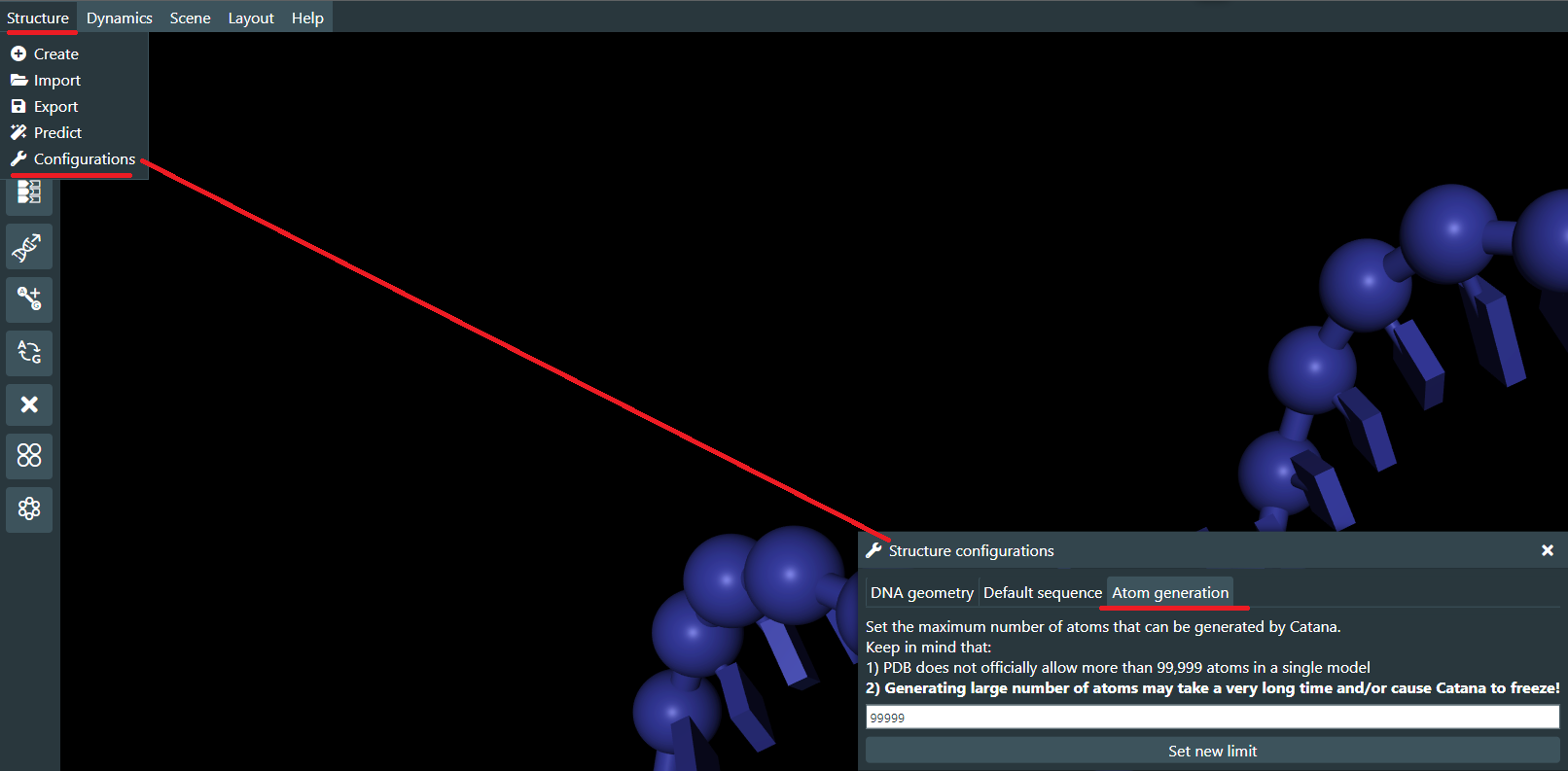Modeling
This section of the user manual describes modeling operations, enabling users to modify the loaded structures. The supported modeling operations depend on the type of the structure being modified (see Core Concepts), while the modeling tools available in the Controls panel depend on the chosen layout (see User Interface). Nevertheless, the modeling works in a similar manner from the user-interaction perspective regardless of the type of structure — Catana currently employs action-object paradigm. Therefore, the user is expected to select the desired modeling operation and then click on the part of the structure he or she wishes to modify.
 All-atom modeling
All-atom modeling
Modeling of fully atomistic structures can be divided into three main subcategories.
Removal of structural parts
Catana allows its users to remove individual atoms, residues, or even whole chains. This enables to quickly remove unnecessary parts of the structure.
Mutation of residues
The users can use Catana to perform residue mutations, replacing the given amino acid with a new one. When combined with Catana's visualization possibilities, the users can easily mutate selected residues and then higlight them to emphasize the changed location.
Appending of residues
Finally, Catana also allows for appending of residues to N- and C- termini of amino acid chains. For example, the following image shows a user appending hexa histidine-tag to the C-terminus of a chain, followed by visualization of appended amino acids in ball and stick representation. By default, the newly appended residues are aligned with the backbone direction of the last residue of the chain. However, the user is given possibility to change the direction in which the residues will be appended (using the 2D and 3D gizmos) — to prevent occurence of a sterical clash, for example.

 Coarse-grained modeling
Coarse-grained modeling
Catana provides various modeling features known from the area of DNA nanotechnology. Some of them are listed below.
Removal of structural parts
Similarly to all-atom modeling, Catana enables to remove parts of coarse-grained structures. It offers removal of amino acids, nucleotides or whole chains, as well as "break" operation (known from Cadnano, for example) allowing for removal of backbone bonds between nucleotides, effectively cutting the given strand into two parts.
Nucleotide mutations
Mutations can be split into two core types:
- Single nucleotide substitution mutations: allow for changing the type of a selected nucleobase
- Setting the strand sequence: this operation will change the sequence of every nucleotide in the selected strand. To perform this, the user is expected to set the desired sequence using the option available in the Sequence tab in Inspector panel. The process of changing strand sequence is visualized below. Note that if the sequence is shorter than the given DNA strand, it will be repeated.

Breaking and connecting of single strands
As mentioned above, the users can also break single strands or join two existing ones into a new one. This allows for creation of DNA origami crossovers. For example, in the image below, the user joined two structures by removing two phosphodiester bonds and then adding new one, connecting the two strands together.

Creation of DNA strands
Furthermore, Catana provides various ways how to create DNA single and double strands from scratch. One of these is to use the corresponding tools from the Controls panel. When the user selects such a tool, he or she is expected to click and drag a mouse, determining the length and direction of the newly created helix. This procedure is visualized below.

Data model conversions
Catana allows to convert between the fully-atomistic structures and coarse-grained ones to enable transition between these two paradigms. In this regard, parametrization of the coarse-grained model, as well as the conversion procedure, is based on the standards defined by the Unified Nanotechnology Format. The conversion can be accessed via the Inspector view, as shown in the image below.

Conversion from coarse-grained model to fully atomistic one can be also perceived as a process of atom generation. In this regard, Catana uses the parameters of the coarse-grained model as a basis for the generation, followed by subsequent optimization of phosphodiester bond lenghts. Currently, up to 99,999 atoms can be generated by default, while this limit can be increased directly in Catana using the Structure configurations section.
